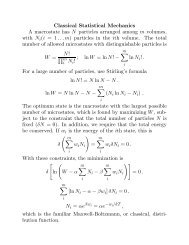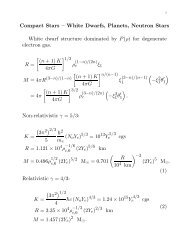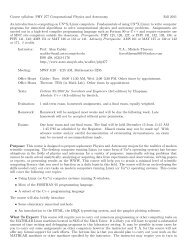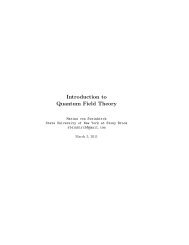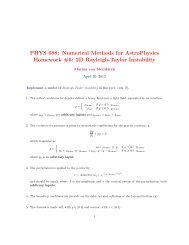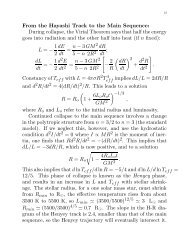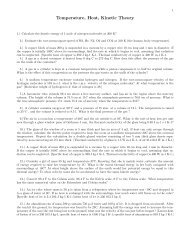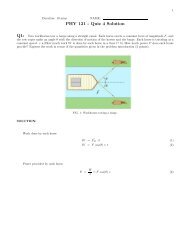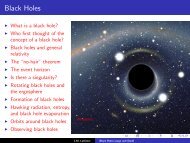Download - Baader Planetarium
Download - Baader Planetarium
Download - Baader Planetarium
Create successful ePaper yourself
Turn your PDF publications into a flip-book with our unique Google optimized e-Paper software.
May 2008 – English Revision v1.1<br />
The DADOS spectrograph project is a collaboration of:<br />
• Max-Planck Institut für Extraterrestrische Physik<br />
www.mpe.mpg.de<br />
• CAOS<br />
www.eso.org/projects/caos/<br />
• <strong>Baader</strong> <strong>Planetarium</strong> GmbH<br />
Zur Sternwarte<br />
D - 82291 Mammendorf<br />
Tel.: +49 (0) 8145 - 88 02<br />
Fax: +49 (0) 8145 - 88 05<br />
www.baader-planetarium.de<br />
2
3<br />
DADOS Spectrograph<br />
User’s Guide<br />
Thank you for purchasing this <strong>Baader</strong> <strong>Planetarium</strong> product.<br />
To get the most out of your DADOS Spectrograph, please<br />
read this instruction manual thoroughly before starting to work<br />
with the spectrograph. Keep this User’s Guide available for<br />
future reference and visit the <strong>Baader</strong> <strong>Planetarium</strong> website:<br />
http://www.baader-planetarium.de for up to date information<br />
about the product.
Unpacking<br />
As you unpack the spectrograph, check the list below and<br />
make sure that all items shown above are included. If anything<br />
is missing contact your original retailer.<br />
Standard accessories:<br />
- DADOS spectrograph - Allan Wrench 1.5 mm<br />
- Eyepiece 20mm - Allan Wrench 1.3 mm<br />
- Eyepiece 10mm - Slit Viewer Assy<br />
- Focusing eyepiece holder (#2458125)<br />
- 1 ¼" Stop ring<br />
- T-2 Quick changing system (#2456313 + #2456320)<br />
4
5<br />
Part description<br />
1. 2” Nosepiece<br />
2. Slit illuminator<br />
3. 1 ¼” Slit viewer port<br />
4. Slit viewer port locking screws<br />
5. Micrometer<br />
6. Rotation stage counter spring<br />
(pre-adjusted do not touch)<br />
7. Focuser<br />
8. Focuser locking screw<br />
9. Grating angle locking screw<br />
For a full list of accessories see Appendix D
6<br />
Table of Contents<br />
1. INTRODUCTION 8<br />
2. QUICK SETUP 10<br />
2.1 Attaching an eyepiece to the focuser 10<br />
2.2 Focusing the spectrum 11<br />
2.3 Changing the spectral range 13<br />
2.4 Observing some common light sources 14<br />
3. CONFIGURING DADOS FOR ASTRONOMICAL<br />
OBSERVATION 18<br />
3.1 Coupling a detector to DADOS 19<br />
3.1.1 Astronomical CCD camera<br />
3.1.2 SLR or D-SLR body<br />
19<br />
22<br />
3.2 Fine focusing of the camera objective 24<br />
3.3 Selecting wavelength range 25<br />
3.4 Using the slit-viewer 26<br />
3.4.1 Attaching an eyepiece to the slit-viewer 26<br />
3.4.2 Attaching a webcam to the slit-viewer 28<br />
3.4.3 Zoom in/out of the slit view 31<br />
3.5 Coupling the spectrograph to the telescope 33<br />
3.6 Operating the spectrograph at the telescope 34<br />
APPENDIX A: MAINTENANCE 36<br />
A.1 Battery replacement 36<br />
A.2 Grating replacement 37
7<br />
APPENDIX B: CARE OF THE OPTICAL<br />
COMPONENTS 43<br />
APPENDIX C: SPECIFICATIONS 44<br />
APPENDIX D: OPTIONAL ACCESSORIES 46<br />
APPENDIX E: BIBLIOGRAPHY 48
8<br />
1. Introduction<br />
The DADOS spectrograph is an instrument which permits to<br />
obtain spectra from different light sources.<br />
The name DADOS means “dice” in spanish.<br />
It was designed to be used as spectroscope and as<br />
spectrograph mainly for astronomical and didactical purposes.<br />
The device is very easy to use, robust, and versatile.<br />
Please carefully read trough this manual to achieve the<br />
maximum use from this device.<br />
Description of DADOS main features:<br />
• Optimized for telescopes up to 14” aperture at f/10.<br />
• Choice of 3 slits: 25, 35 and 50 µm.<br />
• A Red LED provides back illumination to the slit for<br />
easy focusing of a guider camera.<br />
• Default grating of 200 l/mm for low resolution,<br />
optional 900 l/mm grating for higher resolution.<br />
• Micrometer for fine positioning of the central<br />
wavelength.<br />
• Camera objective with wide focusing range including<br />
standard T2 adapter thread (M42 x 0.75).<br />
• Accepts most CCD and DSLR cameras (with<br />
optional adapters). The camera interface is a T2<br />
adapter with a standard M42 x 0.75 thread.<br />
• Wide focusing range up to 55 mm, suitable for<br />
attaching a DSLR-camera.
9<br />
WARNING<br />
Never aim DADOS straight to the Sun!<br />
Irreversible eye damage may occur!
10<br />
2. Quick setup<br />
2.1 Attaching an eyepiece to the focuser<br />
Remove the T-2 dust cap by<br />
rotating it counterclockwise.<br />
Mount the <strong>Baader</strong> T-2 quick<br />
changing system (#2456313<br />
+ #2456320).<br />
Lock the <strong>Baader</strong> T-2 quick<br />
changing system and mount<br />
the focusing <strong>Baader</strong> eyepiece<br />
holder (#2458125).
Insert the DADOS 20mm<br />
eyepiece into the focusing<br />
eyepiece holder.<br />
Lock the eyepiece with any of<br />
the three lock screws.<br />
2.2 Focusing the spectrum<br />
Point the 2” nosepiece (#1) to<br />
a fluorescent light source or a<br />
Neon lamp.<br />
Do not point<br />
directly to the<br />
Sun<br />
Rotate the focuser (#7) in<br />
order to focus onto the<br />
spectrum.<br />
11
12<br />
Lock the focus with locking<br />
screw once sharp focus is<br />
achieved.<br />
Rotate the focusing eyepiece<br />
holder for fine focus<br />
adjustments.
13<br />
2.3 Changing the spectral range<br />
Slightly loosen the grating<br />
angle locking screw (#9).<br />
Center the spectral lines of<br />
your choice by adjusting the<br />
micrometer.<br />
Tighten the grating angle<br />
locking screw (#9) to secure<br />
the selected setting.
2.4 Observing some common light sources<br />
With DADOS you can observe and analyze a large variety of<br />
light sources. For a quick set up of the instrument you can<br />
observe in particular:<br />
• Neon lamps<br />
(like pilot lamps in multi-socket distributors or<br />
washing machines)<br />
• Fluorescent lamps<br />
• Continuous spectral sources<br />
(like Tungsten or Halogen lamps)<br />
• Bright daylight<br />
Never point directly<br />
towards the Sun.<br />
14
15<br />
Examples of spectra taken with DADOS and a 200 lines/mm<br />
grating<br />
HeAr calibration lamp<br />
Neon<br />
Continuous 1 st and 2 nd order<br />
Solar spectrum<br />
Note:<br />
Spectra obtained w. Canon 10D EOS Camera at different<br />
grating angles.<br />
Calibration Lamp only glows in the dark. Shield it from<br />
daylight or connect it to DADOS.
16<br />
Examples of spectra taken with DADOS and a 900 lines/mm<br />
grating<br />
HeAr calibration lamp<br />
Neon<br />
Fluorescent<br />
Continuous<br />
Solar spectrum<br />
Note:<br />
Spectra obtained w. Canon 10D EOS Camera at different<br />
grating angles.<br />
Calibration Lamp only glows in the dark. Shield it from<br />
daylight or connect it to DADOS.
18<br />
3. Configuring DADOS for<br />
astronomical observation<br />
The spectrograph should be setup correctly to ensure proper<br />
function.
3.1 Coupling a detector to DADOS<br />
3.1.1 Astronomical CCD camera<br />
DADOS optical design is optimized to cover the field of SBIG<br />
ST-8 or ST-1603ME cameras.<br />
Detectors having larger chip size than 13.8 x 9.2 mm may be<br />
used; however the optical image quality will slightly decrease<br />
at the edges and therefore the resolving power as well.<br />
Prepare the detector to be<br />
used in the observation,<br />
prefarably:<br />
SBIG ST-8 XME / ST-<br />
1603ME / ST-7 XME / ST-<br />
402ME<br />
Use the <strong>Baader</strong> T-2 quick<br />
changer system as ideal<br />
device for coupling and<br />
rotating the camera without<br />
loss of focus.<br />
19
20<br />
Mount the T-2 change ring<br />
onto the SBIG detector.<br />
Mount the quick changer onto<br />
the T-2 male thread of the<br />
DADOS collimator focuser<br />
(#7).<br />
Join the detector and the<br />
change ring combo.<br />
Rotate the camera into the<br />
desired orientation.
21<br />
Clamp the camera by<br />
tightening the locking screw<br />
of the T-2 quick changer.<br />
DADOS with imaging detector<br />
mounted.
3.1.2 SLR or D-SLR body<br />
Obtain the appropriate T-Adapter for your type of camera.<br />
Prepare the DSLR camera<br />
body to be attached to the<br />
spectrograph.<br />
Screw the DSLR T-Ring on<br />
the spectrograph focusing<br />
unit.<br />
Attach the camera to the T-<br />
Ring adapter.<br />
22
23<br />
Open the three set screws of<br />
the Camera T-Ring.<br />
Rotate the camera body into<br />
the desired position.<br />
Lock the three sides set<br />
screws of the camera T-Ring.<br />
DADOS with mounted DSLR<br />
camera.
3.2 Fine focusing of the camera objective<br />
Either you have an astronomical CCD camera or a SRL body,<br />
follow the instructions below to achieve the best possible<br />
focus of the instrument.<br />
Loosen the focuser locking<br />
screw (#8) to focus the<br />
detector.<br />
Rotate the focuser (#7) in<br />
order to focus onto the<br />
spectrum.<br />
Lock the focus with locking<br />
screw (#8) when sharp focus<br />
is seen or recorded.<br />
24
25<br />
3.3 Selecting wavelength range<br />
Slightly loosen the grating<br />
angle locking screw (#9).<br />
Center on certain spectral<br />
lines by rotating the<br />
micrometer (#5).<br />
Prepare spectral<br />
charts of lab<br />
lamps *<br />
Tighten the grating angle<br />
locking screw to secure the<br />
selected setting.<br />
∗<br />
If you want to download the spectral charts<br />
of some laboratory lamps go, for example,<br />
to http://www.eso.org/projects/caos/
3.4 Using the slit‐viewer<br />
3.4.1 Attaching an eyepiece to the slit‐viewer<br />
Mount the slit viewer<br />
assembly onto the 20mm<br />
DADOS pointing eyepiece.<br />
Slit viewer assembly with<br />
eyepiece.<br />
Slide the 1 ¼” stop ring onto<br />
the eyepiece chrome sleeve<br />
and lock it.<br />
Insert the eyepiece assembly<br />
into the 1 ¼” slit viewer port<br />
(#3).<br />
26
27<br />
Focus onto the slit by<br />
manually pushing or pulling<br />
the eyepiece.<br />
After having focused the<br />
image of the three slits, lock<br />
the eyepiece by using the<br />
locking screw (#4) of the 1 ¼”<br />
slit viewer port (#3).<br />
Open the set screws of the<br />
stop ring and move the stop<br />
ring down to sit flush on top<br />
of the eyepiece holder.<br />
Tighten the stop ring to<br />
secure proper focus position.<br />
DADOS with mounted slit<br />
viewer assembly.
28<br />
3.4.2 Attaching a webcam to the slit-viewer<br />
Remove the 18mm long<br />
1 ¼” extension tube of the<br />
slit viewer assy.<br />
Mount the remaining body of<br />
the slit viewer onto the 1 ¼”<br />
nosepiece of the webcam.<br />
Example: Celestron<br />
NexImage w. 1 ¼”<br />
nosepiece #825100<br />
Slide the 1 ¼” stop ring onto<br />
the webcam nosepiece.
29<br />
Attach the webcam combo<br />
into the 1 ¼” slit viewer port<br />
(#3).<br />
Focus the Webcam by<br />
manually pushing or pulling<br />
it. Rotate the Webcam body<br />
until it is approximately<br />
aligned with the major axis<br />
of DADOS.<br />
After having focused the<br />
image of the three slits, lock<br />
the webcam combo by using<br />
the locking screws (#4) of<br />
the 1 ¼” slit viewer port (#3).<br />
Open the set screws of the<br />
stop ring and move it to sit<br />
flush on top of the eyepiece<br />
holder / slit viewer port.
30<br />
Tighten the Stop Ring to<br />
secure proper focus position.<br />
Realign the orientation of the<br />
slit by rotating the Webcam.<br />
DADOS with Webcam<br />
mounted on to the slit viewer<br />
port.
3.4.3 Zoom in/out of the slit view<br />
The lens inside the slit viewer can be adjusted in order to<br />
magnify the image size of the 3 slits on the detector of the<br />
Webcam.<br />
Remove the second 1 ¼”<br />
extension tube from the slit<br />
viewer body.<br />
Loosen the headless set<br />
screw inside the slit viewer<br />
body by only ½ turn, using<br />
the supplied Allen wrench<br />
(1.3mm).<br />
Slide the lens holder tube<br />
towards the Webcam to<br />
reduce image size.<br />
31
32<br />
Minimum magnification as<br />
seen by the CCD chip.<br />
Slide the lens holder tube<br />
away from the Webcam in<br />
order to magnify the image.<br />
Maximum magnification as<br />
seen by the CCD chip.<br />
Lock the new position of the<br />
lens holder tube by tightening<br />
the headless set screw.<br />
Remount the slit viewer body<br />
onto the webcam with one<br />
18mm extension tube.
33<br />
3.5 Coupling the spectrograph to the<br />
telescope<br />
Use the provided 2”<br />
nosepiece to attach DADOS<br />
to your telescope.<br />
Alternatively use the female<br />
T-2 thread (M42 x 0.75), by<br />
removing the 2” nosepiece.<br />
Or remove the female T-2<br />
thread adapter to get access<br />
to a female 2” thread in<br />
DADOS body.
3.6 Operating the spectrograph at the<br />
telescope<br />
Before attaching DADOS to the telescope, make sure you<br />
have previously focused the spectrum on the camera with the<br />
proper orientation.<br />
Attach DADOS onto the<br />
Telescope with a 2” interface if<br />
using the 2” nosepiece.<br />
Select the alignment between<br />
telescope and instrument. With<br />
equatorial mounts the best<br />
orientation of the instrument is<br />
that the slit is parallel to the right<br />
ascension axis of the telescope.<br />
Ensure the attachment of the<br />
instrument to the telescope by<br />
locking the proper adapter<br />
screws. Then, slew the<br />
telescope to a bright star.<br />
34
35<br />
Use the focusing screw of the<br />
telescope to focus the star in the<br />
middle of the slit by observing its<br />
image through an eyepiece or<br />
webcam.<br />
Use the slit illuminator (#2) to<br />
illuminate the slits and slowly<br />
slew the telescope to bring the<br />
star inside one of the slits.<br />
Switch off the slit illuminator<br />
before starting an exposure with<br />
the detector.
36<br />
Appendix A: Maintenance<br />
A.1 Battery replacement<br />
Simply turn the back of the<br />
Illuminator counterclockwise<br />
approximately three turns to<br />
open the battery<br />
compartment.<br />
Replace worn-out batteries<br />
with two round “hearing aid”<br />
batteries 1.5V (such as<br />
Camilion AG 3 LR 41<br />
#2454306).<br />
Then turn the back of the<br />
illuminator clockwise till it is<br />
completely closed.
37<br />
A.2 Grating replacement<br />
Attention<br />
Touching the grating will destroy it beyond repair!<br />
Do not attempt to remove dust by breathing or blowing air<br />
onto the grating! Small droplets of moisture and saliva can<br />
permanently damage the grating as well.<br />
Do not use compressed or canned air! This will likewise<br />
transport moisture, grease or flocks of gas propellant onto the<br />
grating.<br />
Any exchange of grating holders should always be performed<br />
in clean surroundings, free of dust and static build up.<br />
Arrange your workplace for ensure a quick and tidy grating<br />
exchange.
38<br />
Have the 900L grating with<br />
holder readily available.<br />
Loosen the grating angle<br />
locking screw (#9) by one<br />
turn only.<br />
Rotate the micrometer<br />
backwards to show an 8mm<br />
setting on the Vernier scale.<br />
Use the 1.5 mm Allen wrench<br />
to remove the four Hex-Head<br />
screws.
39<br />
Take off the side plate with<br />
the complete grating holder<br />
assembly.<br />
Be careful not to<br />
touch the grating.<br />
Release the headless set<br />
screw inside of the pressure<br />
plate by 2 full turns<br />
counterclockwise using the<br />
1.5 mm Allen wrench.<br />
Remove the grating holder<br />
from the pressure plate.<br />
Take the 900L grating holder<br />
out of the storage container<br />
and store the 200L grating in<br />
it.
40<br />
Place the 900L grating holder<br />
into the pressure plate.<br />
Rotate the grating holder to<br />
adjust the proper position in<br />
regard to the markings in the<br />
pressure plate.<br />
Each mark indicates the<br />
position of a specific grating.<br />
Be sure to use the proper one<br />
to achieve the optimal<br />
throughput.<br />
Example of position:<br />
200 lines/mm grating.
41<br />
Example of position:<br />
900 lines/mm grating.<br />
Lock the pressure plate by<br />
tightening the headless set<br />
screw clockwise.<br />
Carefully relocate the side<br />
plate with the new grating.<br />
Relocate the 4 screws that<br />
secure the side plate.
42<br />
Retighten the micrometer into<br />
a Vernier position of 2.5 or<br />
around.<br />
Lock the grating tilt<br />
mechanism by rotating the<br />
grating angle locking screw<br />
clockwise.<br />
DADOS with grating<br />
exchanged.
43<br />
Appendix B: Care of the<br />
Optical components<br />
If you always use dust caps after finishing on working with the<br />
DADOS, no cleaning will be necessary.<br />
Grating and slit can only be cleaned from dust by <strong>Baader</strong>-<br />
<strong>Planetarium</strong>. Do not clean gratings or slit, it may void the<br />
warranty.<br />
Lenses cannot be cleaned with common cleaning agents.<br />
Only use <strong>Baader</strong> <strong>Planetarium</strong> Optical Wonder fluid<br />
(#2905007) to clean the lenses.
44<br />
Appendix C: Specifications<br />
Mechanical<br />
Weight (without cameras and<br />
eyepieces)<br />
Dimensions (see Figure in Part<br />
Description)<br />
Electrical<br />
Red LED Battery<br />
0.85 kg<br />
80 × 150 × 205<br />
mm<br />
LR 41 or<br />
equivalent<br />
Environmental<br />
Operating temperature<br />
-10 to +30 o C<br />
Storage temperature<br />
-30 to +35 o C<br />
Humidity (relative) 0 to 80 %<br />
Storage humidity 0 to 60 %<br />
Optical<br />
Collimator aperture f/10 *<br />
Collimator focal distance<br />
80 mm<br />
Objective focal distance<br />
96 mm<br />
Collimator – Camera angle<br />
90 o<br />
Dispersion on axis at 550 nm<br />
‐ 200 lines/mm grating<br />
‐ 900 lines/mm grating (optional)<br />
39.7 nm/mm<br />
10.6 nm/mm<br />
*<br />
Operating at lower f/# degrades the resolving power and<br />
increases the vignetting
Performances<br />
Resolving power λ / ∆ λ on camera objective axis and 25 µm slit<br />
Grating of 200 lines/mm<br />
Theoretical Measured λ (nm)<br />
396 542 @ 416<br />
606 647 @ 616<br />
668 723 @ 697<br />
Grating of 900 lines/mm<br />
Theoretical Measured λ (nm)<br />
2038 2000 @ 371<br />
3910 3000 @ 561<br />
5376 5000 @ 800<br />
Limiting magnitude for a 30 cm Ø telescope with S/N 50 and<br />
20 minutes of exposure time.<br />
For the 200 lines/mm grating : m v = 8<br />
For the 900 lines/mm grating : m v = 6<br />
Note:<br />
Measurements performed w. ST-8 XME w. 9 micron pixel<br />
size.<br />
The measured resolving power of the 900L grating was limited<br />
by the pixel matching.<br />
With smaller pixels a higher resolution can be measured.<br />
45
46<br />
Appendix D: Optional accessories<br />
T2 adapters for many SLR<br />
camera models. Examples:<br />
Nikon Ref. 240 8300<br />
Canon EF Ref. 240 8319<br />
Look at <strong>Baader</strong> <strong>Planetarium</strong><br />
Web site for a complete list.<br />
Reflection grating<br />
25 x 25 x 9mm, 900 lines/mm<br />
mounted in quick exchanger.<br />
Ref. 245 8555<br />
Calibration Neon lamp for<br />
DADOS with 220V power<br />
cord and 2" adapter.<br />
Ref. 245 8590<br />
Travel case for DADOS with<br />
flexible compartments for<br />
tools.<br />
Ref. 245 2110
48<br />
Appendix E: Bibliography<br />
Stars and their spectra: An<br />
introduction to spectral sequence<br />
Author: James B. Kaler<br />
Pub 1989<br />
Pages: 300<br />
ISBN: 0521304946<br />
The spectra and structures of<br />
simple free radicals: An<br />
introduction to molecular<br />
spectroscopy<br />
Author: Gerhard Herzberg<br />
Pub 1989<br />
Pages: 300<br />
Getting the measure of the stars<br />
Author: W.A. Cooper<br />
Pub 1989<br />
Pages: 293<br />
ISBN: 0852748302
49<br />
Handbook of CCD astronomy<br />
Author: Steve Bruce Howell<br />
Pub 2006<br />
Pages: 208<br />
ISBN: 0521852153<br />
Astronomical spectroscopy : An<br />
introduction to the atomic and<br />
molecular physics of astronomical<br />
spectra<br />
Author: Jonathan Tennyson<br />
Pub 2005<br />
Pages: 192<br />
Spectroscopy : The key to the stars:<br />
Reading the lines in stellar spectra<br />
Author: Keith Robinson<br />
Pub 2007<br />
Pages: 160<br />
ISBN: 9780387367866
50<br />
Foundations of astronomy.<br />
Author: Michael A. Seeds<br />
Pub 2000<br />
Pages: 656<br />
ISBN: 0534378552<br />
The observation and analysis of<br />
stellar photospheres<br />
Author: David F. Gray<br />
Pub 2005<br />
Pages: 533<br />
ISBN: 0521851866<br />
Observing variable stars<br />
Author: Gerry A. Good<br />
Pub 2003<br />
Pages: 274<br />
ISBN: 1852334983
51<br />
Physics of star formation in<br />
galaxies<br />
Author: Francesco Palla<br />
Pub 2002<br />
Pages: 232<br />
ISBN: 3540431020<br />
The analysis of Starlight. One<br />
hundred and fifty years of<br />
astronomical spectroscopy<br />
Author: John B. Hearnshaw<br />
Pub 1987<br />
Pages: 531<br />
ISBN: 0521255481<br />
An introduction to the theory of<br />
stellar structure and evolution<br />
Author: Dina Prialnik<br />
Pub 2000<br />
Pages: 261<br />
ISBN: 9780521659376
52<br />
Optical astronomical spectroscopy<br />
Author: Christopher R. Kitchin<br />
Pub 1995<br />
Pages: 272<br />
ISBN: 0750303468<br />
Atomic spectra and atomic<br />
structure<br />
Author: Gerhard Herzberg<br />
Pub 2007<br />
Pages: 527<br />
ISBN: 140675322X<br />
Observers Guide to Stellar<br />
Evolution<br />
Author: Mike Inglis<br />
Pub 2007<br />
Pages: 236<br />
ISBN: 1852334657
53<br />
Spectrograph Design Fundamentals<br />
Author: John James<br />
Pub 2007<br />
Pages: 204<br />
ISBN: 10-0521864631<br />
Practical amateur spectroscopy<br />
Author: Stephen F. Tonkin et al.<br />
Pub 2002<br />
Pages: 210<br />
ISBN: 1852334894<br />
Journey from the center of the sun<br />
Author: Jack B. Zirker<br />
Pub 2002<br />
Pages: 302<br />
ISBN: 0691057818
54<br />
The behavior of chemical elements<br />
in stars<br />
Author: Carlos Jaschek<br />
Pub 1995<br />
Pages: 324<br />
ISBN: 052141136X<br />
The classification of stars<br />
Author: Carlos Jaschek<br />
Pub 1990<br />
Pages: 413<br />
ISBN: 0521267730<br />
Introduction to Stellar Astrophysics.<br />
Vol.3: Stellar structure and<br />
evolution<br />
Author: Erika Boehm-Vitense<br />
Pub 1992<br />
Pages: 285<br />
ISBN: 0521348714
56<br />
WAVELENGTH SETTINGS<br />
Camera<br />
Model:____________________<br />
Micrometer position<br />
Grating:___________<br />
_<br />
Central Wavelength<br />
Camera<br />
Model:____________________<br />
Micrometer position<br />
Grating:___________<br />
_<br />
Central Wavelength<br />
Camera<br />
Model:____________________<br />
Micrometer position<br />
Grating:___________<br />
_<br />
Central Wavelength
57<br />
WAVELENGTH SETTINGS<br />
Camera<br />
Model:____________________<br />
Micrometer position<br />
Grating:___________<br />
_<br />
Central Wavelength<br />
Camera<br />
Model:____________________<br />
Micrometer position<br />
Grating:___________<br />
_<br />
Central Wavelength<br />
Camera<br />
Model:____________________<br />
Micrometer position<br />
Grating:___________<br />
_<br />
Central Wavelength
58<br />
NOTES
NOTES<br />
59
60<br />
No reproduction in any form of this manual in whole<br />
or in part (except for brief quotation in critical<br />
articles or reviews) may be made without written<br />
authorization of <strong>Baader</strong> <strong>Planetarium</strong> GmbH.<br />
<strong>Baader</strong> <strong>Planetarium</strong> GmbH<br />
Zur Sternwarte<br />
D - 82291 Mammendorf<br />
Tel.: +49 (0) 8145 - 88 02<br />
Fax: +49 (0) 8145 - 88 05<br />
www.baader-planetarium.de



